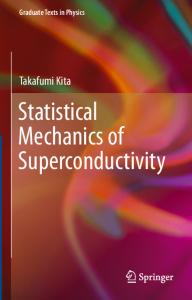Understanding superconductivity
- PDF / 1,822,417 Bytes
- 1 Pages / 604.8 x 806.4 pts Page_size
- 90 Downloads / 355 Views
Understanding Superconductivity The cold world of superconductivity celebrates some memorable anniversaries this year and next. Seventy-five years ago, in 1911, Dutch physicist Heike KamerlinghOnnes discovered that some metals lost all electrical resistance when cooled to nearly absolute zero. Called superconductivity, this low-temperature property came as a bit of a shock to many scientists at the time. Lord Kelvin had predicted in 1902 that as a metal was cooled its resistance should reach a minimum but then rise to become infinite as the electrons eventually condensed onto the metal atoms. A leading low-temperature experimenter, Kamerlingh-Onnes founded the notable Cryogenics Laboratory in Leiden, first liquified helium (in 1908), and even coined the word cryogen (from the Greek kryos for cold and -gen meaning to become.) Before his experiments, Kamerlingh-Onnes had thought the resistance of cold metals would go to zero because the source of the resistance, Planck vibrators, would lose their energy at the lowest temperatures. But, in the words of Leiden experimentalist Hendrik B.G. Casimir, "If the atomic motion would follow the laws of classical mechanics, low-temperature physics might well be a dull subject." Which, of course, was not to be. On the surface, though, superconductivity might look dull even to an enthusiast. Casimir recalled that he and his wife Josina "in youthful enthusiasm, once observed a whole night long . . . the current circulating in a circuit." "We did not find any change in the current," he said. "I like to say that the resistance of superconductors is about the zeroest quantity we know." But at an atomic level, a lot was going on to create that zero condition. Kamerlingh-Onnes found that the metals showed a discontinuous decrease of resistance to zero and that different metals
had different transition temperatures. This meant a new explanation of superconductivity was needed. Not until 1957, 30 years ago next year, was a comprehensive theory devised to describe superconductivity. This is the famous BCS theory, which won its originators—John Bardeen, Leon Cooper, and J. Robert Shrieffer—the 1972 Nobel Prize for Physics. The trio found that the key to understanding superconductivity is a pairing interaction between the electrons resulting from an effective attraction induced by the interaction between electrons and atomic vibrations. The BCS theory not only accounted for the major aspects of superconductivity, but was used to predict new phenomena and gave a great stimulus to the field. Foremost of the new phenomena were those concerning two strips of superconductor separated by a thin oxide predicted by Brian D. Josephson a quarter century ago (1961-1962) when he was a research student at the Mond Laboratory in Cambridge (England). Josephson calculated that two supercurrents would form in the type of "junction" that now bears his name. One current would be continuous direct current, persisting without an electromotive force just as it would in an ordinary superconductor. The second curr
Data Loading...











